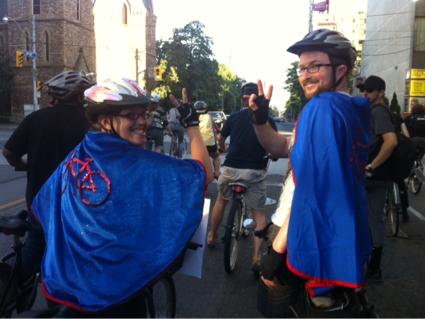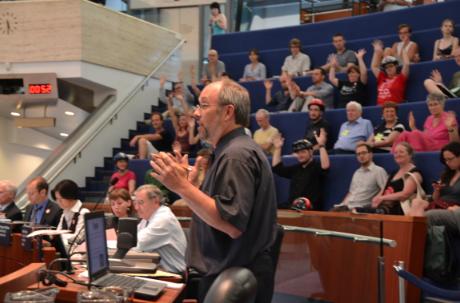
In protest of city council's decision to cut bike lanes, more than 120 cyclists organized an impromptu "critical mass" protest up and down Jarvis July 13 Credit: Andrea Houston

Cyclists protesting city council's decision to remove bike lanes. Credit: Andrea Houston
UPDATE, 15 JUL – The Toronto Cyclists Union is organizing a Ride for Jarvis event to protest the City of Toronto’s decision to erase the bike lanes on Jarvis St. It’s scheduled for Wednesday, Jul 20 at 6:30pm at Allan Gardens. Check it out here.
JUL 14 – For the hundreds of cyclists that packed city hall’s council chamber for two straight days this week, the fight for bike lanes on Jarvis St has just begun.
Just hours after the vote to kill bike lanes on three streets in the city July 13, about 120 cyclists strapped on their helmets to ride up and down Jarvis to protest what many are calling “a massacre by Mayor Rob Ford.”
Council voted to remove the bike lanes on Jarvis St and return the road to its original five-lane configuration at an estimated cost of around $200,000. That’s not supposed to happen until a separated lane is built on neighbouring Sherbourne St in 2012.
And the cuts kept coming. Councillors also voted to kill the bike lanes on Birchmount Rd and Pharmacy Ave in Scarborough. The city will spend more than $400,000 to erase the all the bike lanes. The lanes on Jarvis were installed last July at a cost of $59,000. However, there is one glimmer: a bike lane will be added on Dawes Rd.
The two-day debate was exhausting, frustrating, absurd and childish. Right-wing councillors dug in their heels while the left stood its ground and fought back. Behind them, more than 400 community members reacted with “jazz hands” waving high in the air.
Then, when Councillor Janet Davis was blocked from voting on each recommendation, a handful of left-wing councillors got up and walked out in protest. They included councillors Gord Perks, Kristyn Wong-Tam, Davis, Shelley Carroll and Mike Layton.
Wong-Tam says re-installing the fifth lane contradicts the main objective of the Jarvis St Streetscape Plan and Environmental Assessment. She says the community has been completely shut out of the process.
“This is not what the community is asking for,” says Wong-Tam, whose ward includes Jarvis. “This throws out all the local planning and community efforts to beautify Jarvis, which have been ongoing and council has earmarked money for. This council has decided Jarvis is not a cultural corridor.”
“Removing bike lanes does not remove cyclists from the roads,” she says. “They will still be there, but no longer be safe.”
The criticism came fast and furious. Twitter lit up with angry reactions and Facebook was flooded with comments. Cyclists poured into council chambers, many wearing helmets, demanding to be heard.
Cycling activists called it a “sad day for Toronto.” Toronto Cyclists Union founder Dave Meslin says Ford has ignored facts, ignored the democratic process, ignored public opinion, avoided community consultation and has put cyclist’s safety at risk.
Andrea Garcia, advocacy director for the Toronto Cyclists Union, tells Xtra democracy was hijacked. “We are extremely disappointed with this entire process. The Ford administration chose to stifle citizens today. Frankly, it’s insulting to taxpayers. The councillors who walked out have principles and believe decisions should be made on evidence, not ideology.”
“Ford is more interested in running government like a corporation, not a democracy,” she adds.
Throughout the debate, other councillors stood to make impassioned appeals. Councillor Joe Mihevc says removing bike lanes is an attack on the environment. While other cities worldwide are installing bike lanes at a rapid rate to accommodate a growing number of people using bikes over cars, Toronto is alone in moving backward, he says.
At one point, Councillor Glenn De Baeremaeker questions Ford’s manhood, triggering a sharp tongue-lashing from Nunziata. De Baeremaeker told council he hopes “Ford will send flowers to the funeral of dead cyclists if they are struck and killed” as a result of bike lanes being removed.
Councillor Pam McConnell says removing bike lanes is a dangerous liability for the city. “This is exposing us to a very serious lawsuit if anyone dies. Removing bike lanes is not banning bikes.” Councillor Adam Vaughan called the move another example of Ford’s wasteful spending, and Mike Layton, who presented a petition with 2,000 signatures to save the Jarvis lanes, says bike lanes save lives.
“Frankly, I’m confused and I’m scared,” Layton told council. “Those 13 cyclist fatalities between 2005 and 2010 are only bound to rise if we reduce our cycling infrastructure.”
Day two of debate began with Councillor Shelley Carroll screening an old video clip of Councillor Giorgio Mammoliti vehemently supporting the Jarvis bike lanes that he now wants out. Mammoliti angrily left the council chamber while the video played.
More protest actions are now being organized on Facebook. An invite has been created for Toronto Take Up The Whole Lane Day on July 16. Organizers are reminding cyclists that it’s legal to take up an entire lane on streets where there are no bike lanes, according to Toronto Police Const Hugh Smith, who helped found the Toronto police bicycle units back in 1989.
The bike lane debate is not about saving money or making streets safer. Councillor Michael Thompson, who voted to kill the bike lanes, called it a “political decision,” pitting downtown residents against suburban drivers.
A report by city staff in June shows the Jarvis lanes are a success. Cycling use has spiked since the lanes went in. The number jumped from 290 during the peak eight hours on a weekday in 2009 to 890 cyclists after. Meanwhile, the number of motor vehicles on Jarvis remained constant, at 13,000 during the same peak hours.

 Why you can trust Xtra
Why you can trust Xtra


